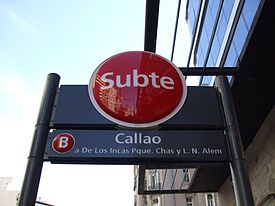Line B (Buenos Aires)
 Line B |
|
|---|---|

Entrance to Callao station
|
|
| Overview | |
| Type | Rapid transit |
| System | Buenos Aires Underground |
| Termini |
Leandro N. Alem Juan Manuel de Rosas |
| Stations | 17 |
| Daily ridership | 412,882 (2009) |
| Operation | |
| Opened | 1930 |
| Operator(s) | Metrovías |
| Character | Underground |
| Technical | |
| Line length | 11.75 km (7.30 mi) |
| Track gauge | 1,435 mm (4 ft 8 1⁄2 in) |
| Electrification | Third rail and catenary |
Line B of the Buenos Aires Underground runs 11.75 kilometres (7.30 mi) from Leandro N. Alem to Juan Manuel de Rosas in Villa Urquiza. Line B opened to the public on 17 October 1930.
In recent years, it has held the title of being the most used line, and increased even more so after the opening of a section of tunnel between Los Incas station in the neighborhood of Parque Chas and a shopping centre in Villa Urquiza. It was the first line in Buenos Aires whose stations had turnstiles and moving stairways.
It is the only line that uses third rail current collection, while the rest collect electric current from overhead lines, though there has been ongoing conversion to overhead lines to incorporate new rolling stock. Its gauge of 4 ft 8 1⁄2 in (1,435 mm) is the same as the rest of the Buenos Aires underground system.
The rolling stock currently used on the B line are former Tokyo Metro (formerly Eidan Subway) 300/500/900 stocks, which was used on Marunouchi Line and CAF 5000 stock. These Japanese units were acquired in the early 1990s, and offer less sitting room than the previous setup, increasing the line's capacity during peak hours. The Japanese trains are being phased out and replaced by newer CAF 5000 and CAF 6000 rolling stock acquired from the Madrid Metro.
In 1912 the Congress of Argentina enacted Law 8,870 to carry out the line that would unite the Correo Central (Central Post Office) and the intersection of Triumvirato and Elcano streets, splice site with the tracks of the Buenos Aires Central Railroad (Ferrocarril Central de Buenos Aires or FCCBA), which belonged to the same business group through an 8.7 km tunnel. The Act provided that the works "would clear in part the traffic in the central area of the city".
...
Wikipedia
